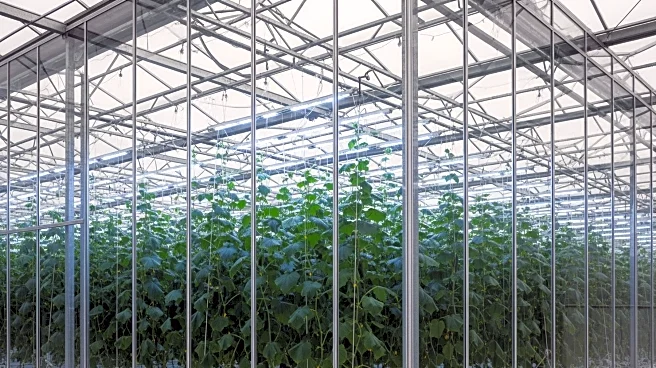What's Happening?
Preston Dairy in Quincy, Michigan, has implemented a significant change in its feeding strategy by incorporating roasted high oleic soybeans into its dairy cow rations. This switch has resulted in increased
milk fat and protein levels, leading to a rise in daily income over feed costs by more than one dollar per cow. The soybeans, grown locally and roasted on the farm, have replaced higher-priced purchased fats, offering a steady source of energy and essential fatty acids. Researchers from Michigan State University have highlighted the benefits of high oleic soybeans, noting their ability to improve milk components and reduce reliance on external feed ingredients. The farm has seen butterfat levels increase from 4.4 percent to 4.8 percent, and demand for these soybeans has surged across Michigan.
Why It's Important?
The adoption of high oleic soybeans by Preston Dairy represents a significant advancement in sustainable farming practices. By utilizing locally grown soybeans, the farm reduces its dependency on imported fats and supplements, which can be subject to price fluctuations. This change not only enhances the nutritional quality of the milk produced but also supports local agriculture, potentially leading to broader economic benefits for the region. The increased profitability per cow suggests that other dairy farms could benefit from similar strategies, promoting a more resilient and self-sufficient dairy industry. The research conducted by Michigan State University underscores the potential for high oleic soybeans to transform dairy farming, offering a win-win scenario of improved production and reduced costs.
What's Next?
As more dairy farms become aware of the benefits of high oleic soybeans, it is likely that adoption will increase, leading to a shift in feed strategies across the industry. This could result in greater demand for locally grown soybeans, encouraging farmers to cultivate these crops and potentially boosting local economies. Additionally, ongoing research may further refine the use of high oleic soybeans, optimizing their impact on milk production and farm profitability. Stakeholders, including agricultural researchers, dairy farmers, and local governments, may collaborate to promote the widespread use of these soybeans, enhancing the sustainability and economic viability of the dairy sector.
Beyond the Headlines
The integration of high oleic soybeans into dairy feed highlights broader implications for agricultural sustainability and food security. By reducing reliance on imported feed ingredients, farms can mitigate risks associated with global supply chain disruptions. This approach also supports environmental sustainability by minimizing transportation emissions and promoting local crop production. Furthermore, the success of this feeding strategy may inspire similar innovations in other agricultural sectors, fostering a culture of research-driven improvements in farming practices. The ethical dimension of supporting local agriculture and reducing environmental impact aligns with growing consumer demand for sustainable and responsibly produced food.














